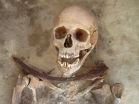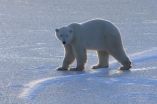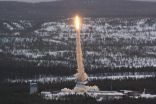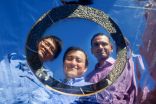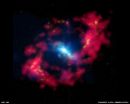DNA may survive suborbital spaceflight, re-entry
Plasmid DNA attached to rocket exterior may survive spaceflight
2014-11-26
(Press-News.org) Plasmid DNA attached to the outer surface of a sounding rocket may be able to withstand rocket launch, a period of residence in suborbital space, re-entry, and landing conditions into the Earth's atmosphere, all the while staying intact and active in its function as carrier of genetic information, according to a study published November 26, 2014 in the open-access journal PLOS ONE by Cora Thiel and Oliver Ullrich from University of Zurich and colleagues.
DNA plays an important role as a biomarker for the search of extraterrestrial signatures of life, and scientists are working to characterize and compare the influence of Earth and space conditions on DNA. The authors of this study designed a test to analyze the biological effects of suborbital spaceflights using the TEXUS-49 rocket mission in March 2011. They attached artificial plasmid DNA carrying a fluorescent marker and an antibiotic resistance gene cassette at three different positions on the rocket exterior, where outer gas temperatures were estimated at over 1000°C during the short 780 second flight.
Researchers analyzed the samples immediately after the flight, and the results showed that DNA survives to varying degrees in all cases, and in particular, even after application of temporary heating up to 1000°C. Subsequent analyses showed that DNA could be recovered from all application sites on the exterior of the rocket, with a maximum of 53% in the grooves of the screw heads. Up to 35% of DNA retained its full biological function, as shown by its ability to successfully confer antibiotic resistance to bacteria, and to drive expression of a fluorescent marker in eukaryotic cells. The authors suggest this experimental design may establish a robust and universal functionality assay to test for the stability of DNA during an atmospheric transit and re-entry, as well as a model for nucleic acids that could serve as biomarkers in the search for past or present extraterrestrial life.
Prof. Ullrich and Dr. Thiel added: "We were totally surprised. Originally, we designed this experiment as a technology test for biomarker stability during spaceflight and re-entry. We never expected to recover so many intact and functional active DNA. But it is not only an issue from space to Earth, it is also an issue from Earth to space and to other planets: Our findings made us a little bit worried about the probability of contaminating space crafts, landers and landing sites with DNA from Earth."
INFORMATION:
In your coverage please use this URL to provide access to the freely available paper: http://dx.plos.org/10.1371/journal.pone.0112979
Citation: Thiel CS, Tauber S, Schutte A, Schmitz B, Nuesse H, et al. (2014) Functional Activity of Plasmid DNA after Entry into the Atmosphere of Earth Investigated by a New Biomarker Stability Assay for Ballistic Spaceflight Experiments. PLoS ONE 9(11): e112979. doi:10.1371/journal.pone.0112979
Funding: Support was provided by the German Aerospace Center (DLR) through grant no. 50WB0912. The funders had no role in study design, data collection and analysis, decision to publish, or preparation of the manuscript.
Competing Interests: The author has declared that no competing interests exist.
[Attachments] See images for this press release:
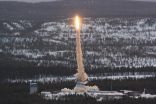
ELSE PRESS RELEASES FROM THIS DATE:
2014-11-26
Potential 'vampires' buried in northwestern Poland with sickles and rocks across their bodies were likely local and not immigrants to the region, according to a study published November 26, 2014 in the open-access journal PLOS ONE by Lesley Gregoricka from University of South Alabama and colleagues.
In northwestern Poland, apotropaic funerary rites--a traditional practice intended to prevent evil--occurred throughout the 17th-18th c. AD. Those of the dead considered at risk for becoming vampires for a variety of reasons were given specific treatment, and investigating ...
2014-11-26
Shifts in the timing and duration of ice cover, especially the possible lengthening of ice-free periods, may impact polar bears under projected warming before the end of the 21st century, according to a study published November 26, 2014 in the open-access journal PLOS ONE by Stephen Hamilton from University of Alberta and colleagues.
Sea ice across the Arctic is declining and altering physical characteristics of marine ecosystems, and polar bears are vulnerable to these changes in sea ice conditions. The authors of this study used sea ice projections for the Canadian ...
2014-11-26
Induced pluripotent stem cells made from patients with a form of blistering skin disease can be genetically corrected and used to grow back healthy skin cells in laboratory dishes, researchers at the Stanford University School of Medicine have found. They've termed the new technique "therapeutic reprogramming."
The skin cells formed normal human skin when grafted onto the backs of laboratory mice, they said.
The findings represent a major advance in the battle against the disease, epidermolysis bullosa, in which the top layer of skin, called the epidermis, sloughs off ...
2014-11-26
Some people say that reading "Harry Potter and the Sorcerer's Stone" taught them the importance of friends, or that easy decisions are seldom right. Carnegie Mellon University scientists used a chapter of that book to learn a different lesson: identifying what different regions of the brain are doing when people read.
Researchers from CMU's Machine Learning Department performed functional magnetic resonance imaging (fMRI) scans of eight people as they read a chapter of that Potter book. They then analyzed the scans, cubic millimeter by cubic millimeter, for every four-word ...
2014-11-26
Applied to the outer shell of the payload section of a rocket using pipettes, small, double-stranded DNA molecules flew into space from Earth and back again. After the launch, space flight, re-entry into Earth's atmosphere and landing, the so-called plasmid DNA molecules were still found on all the application points on the rocket from the TEXUS-49 mission. And this was not the only surprise: For the most part, the DNA salvaged was even still able to transfer genetic information to bacterial and connective tissue cells. "This study provides experimental evidence that the ...
2014-11-26
Scientists investigating the potentially deadly hantavirus have used a novel approach to developing protective antibodies against it. Their work, published in today's online edition of Science Translational Medicine, provides proof of concept for producing antibodies against a broad range of human pathogens.
Hantaviruses cause a condition known as hantavirus pulmonary syndrome (HPS), which has a case fatality rate of 35-40 percent. Currently there are no licensed vaccines, prophylactics, or therapeutics to prevent or treat this highly pathogenic disease.
This research ...
2014-11-26
This news release is available in German.
Scientists led by Kristina Djinović-Carugo at the Max F. Perutz Laboratories (MFPL) of the University of Vienna and the Medical University of Vienna have elucidated the molecular structure and regulation of the essential muscle protein α-actinin. The new findings allow unprecedented insights into the protein's mode of action and its role in muscle disorders. The findings, made in collaboration with King's College London (KCL), may lead to improved treatments, and are published in the top-class journal Cell.
Most ...
2014-11-26
A popular indigestion medication can increase survival in colorectal cancer, according to research published in ecancermedicalscience. But in fact, scientists have studied this for years - and a group of cancer advocates want to know why this research isn't more widely used.
"Cimetidine is an interesting drug as it's very safe, very well-known, and has clinical results in cancer that have been confirmed in a number of trials," says Pan Pantziarka, lead author of the paper and member of the Repurposing Drugs in Oncology (ReDO) project.
Cimetidine treats indigestion ...
2014-11-26
Stanford engineers have invented a revolutionary coating material that can help cool buildings, even on sunny days, by radiating heat away from the buildings and sending it directly into space.
A team led by electrical engineering Professor Shanhui Fan and research associate Aaswath Raman reported this energy-saving breakthrough in the journal Nature.
The heart of the invention is an ultrathin, multilayered material that deals with light, both invisible and visible, in a new way.
Invisible light in the form of infrared radiation is one of the ways that all objects ...
2014-11-26
A team of scientists, led by Dr Sebastian Hoenig from the University of Southampton, have developed a new way of measuring precise distances to galaxies tens of millions of light years away, using the W. M. Keck Observatory near the summit of Mauna Kea in Hawaii.
The method is similar to what land surveyors use on earth, by measuring the physical and angular, or 'apparent', size of a standard ruler in the galaxy, to calibrate the distance from this information.
The research, which is published in the journal Nature, was used to identify the accurate distance of the ...
LAST 30 PRESS RELEASES:
[Press-News.org] DNA may survive suborbital spaceflight, re-entry
Plasmid DNA attached to rocket exterior may survive spaceflight

